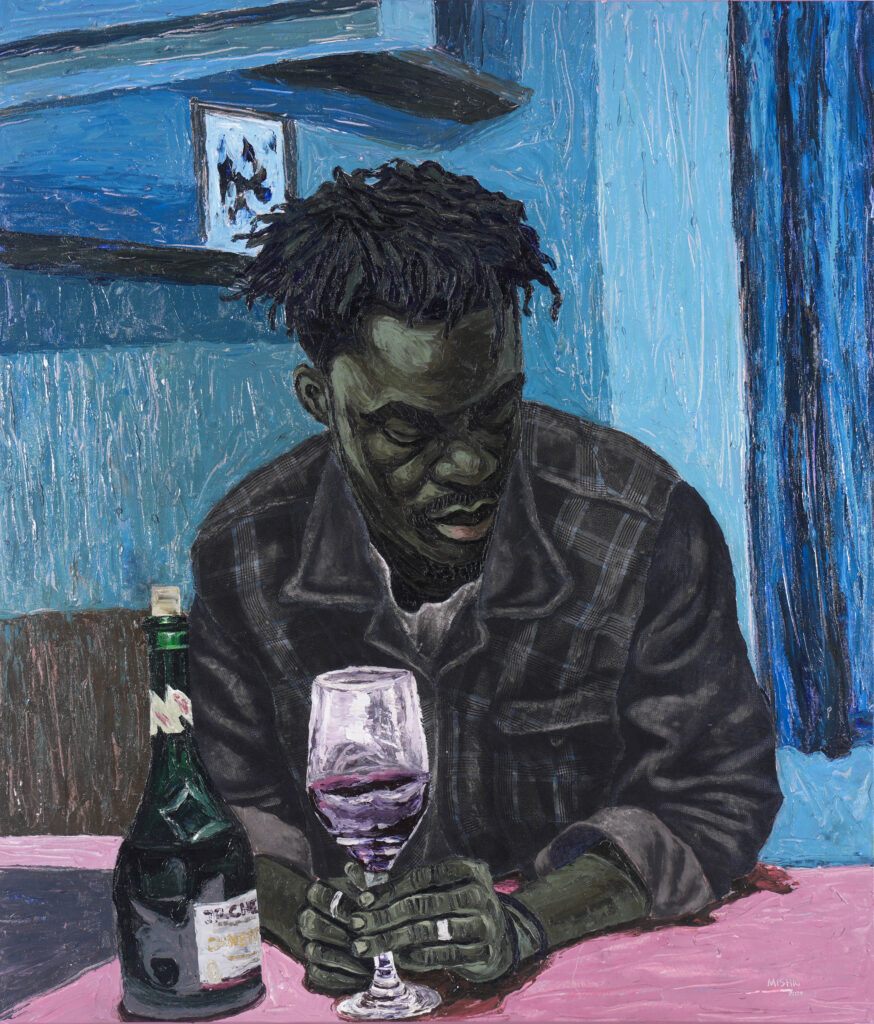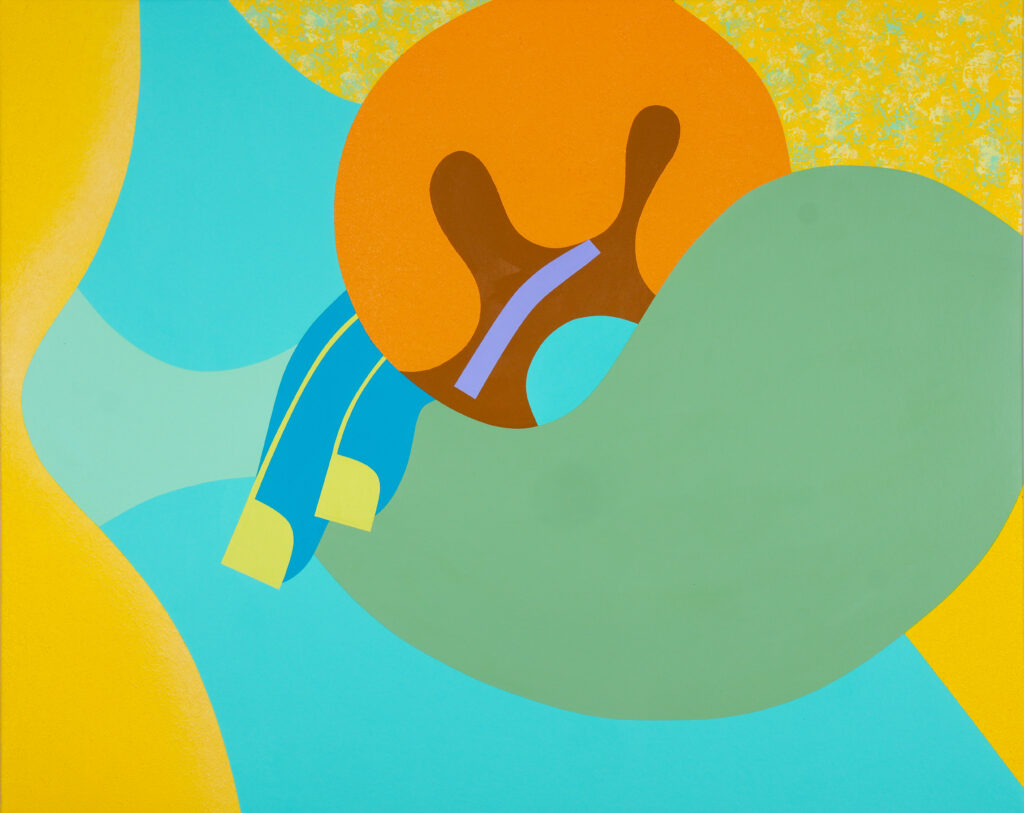26 March–20 May, 2024
Gallery Viewing Room from March to May 2024
G/F & B/F, Printing House, 6 Duddell Street, Central, Hong Kong
Overview
Hong Kong—Pearl Lam is delighted to present talented artists from diverse regions across Africa at its Hong Kong viewing room. This showcase is a heartfelt homage to the continent’s vibrant and multifaceted artistic expressions and is a celebration of African art. It invites visitors to immerse themselves in the beauty and cultural abundance of African artistic traditions, providing an opportunity to embrace and appreciate the richness of this remarkable heritage.
Sthenjwa Luthuli meticulously examines the manifold dynamics of African existence, juxtaposing the traditional with the contemporary, offering a nuanced exploration of pre-modern legacies and post-modern realties. His mixed media works reflect on the hurdles of adaption and survival within ever-evolving societies fragmented by cultural diversity. Touch in the Light portrays Luthuli’s relentless pursuit of the light, acknowledging struggles endured along the way. The carved wooden relief ignites inspiration of endless opportunities the future promises. Amidst the shadows, Moon Rising stands as a testament to the temporary nature of darkness. Through the eternal cycle of the moon, we find hope for renewal and a profound connection to the rhythms of life and the natural world.
James Mishio is a mixed media artist who works with oil, acrylic, pastel, and fabric on canvas. Here, he is represented by two paintings, What Now and A Moment Away II, which depict lone male figures in deep contemplation. Myriads of relatable social issues including the misplacement of identity and intentions are possible preoccupations imposed upon the subjects by the artist’s self-criticism. A poignant scene of introspection portrayed in A Moment Away II features an individual sitting behind a table with a bottle of wine and a wineglass in his hand, underlining the significance of these brief pauses and re-evaluation amidst life’s relentless demands.
Abdur Rahman Muhammad draws from past and contemporary experiences as he uses figuration and impasto technique to make salient social commentaries. The recurring motif of the “Ghana Must Go” bag in his artworks serves as a symbol of migration, bearing the contemplation and hope of the immigrants in their quest for a new life. According to the artist, Random Blurt is inspired by a thought-provoking social media post that asks, “What’s the one thing you blurt out randomly every waking day?” “I for lef Ghana” (I must leave Ghana) was one user’s comment. These spontaneous utterances can reveal deep underlying desires—in this case, a longing to leave one’s native country—as can be discerned in the intense gaze of a young woman carrying a bag. In Green Shimmer, the subject firmly clutches her bag in readiness to emigrate elsewhere.
Chidinma Nnoli’s creative exploration revolves around the convergence of the physical and metaphysical with a thematic emphasis on women. Her deliberate choice of natural hues and soft pastels in her paintings evokes a sense of balance, mirroring the relationship between her subjects and the spaces they occupy. Rooted in both painting and poetry, Nnoli’s work exudes a captivating aura of mystery and coherence. Her poems, like whispered memories, find expression on canvas, creating a visual symphony that resonates with the soul. The effect of her work, as seen in Pieces of My Piece of Mind, which navigates the realms of trauma and the journey towards healing, brings comfort in shared experiences and hope that can be felt universally.
Samuel Nnorom’s works delve into the complex tapestry of identity and meaning encapsulated in textiles. His deliberate use of the African print cloth emerges as a symbolic embodiment of social organisation, intricately knitting together the diverse strands of humanity into the fabric of society. The bubbles serve as vessels, hinting at the capacity to hold aspects of communal life and shared history. Moving on Both Sides explores the concept of the dual nature of existence, capturing the fluidity of human presence in space and the simultaneous embodiment of grace. It celebrates the resilience found in our diversity, portraying our collective movement as a dynamic force that bewilders adversaries and amplifies our strengths. In Sacrificial Living, Nnorom poetically challenges our societal norms, prompting us to consider how we can truly thrive without recognising the indispensable roles of our neighbours.
Deborah Segun fuses Cubism and abstraction to document her shared and personal experiences as a woman. Her playful and purist approach through her figurative representations focuses on the cyclical nature of life that occurs within self-discovery. The blooming flowers in Spring symbolise the rejuvenation of nature that occurs during springtime. This sense of newness is also conveyed in Enrichment with vibrant green foliage evoking vitality and the freshness of new growth. These paintings serve as a documentation of Segun’s process of starting over and reprogramming herself to be more in tune with her new surroundings.
Emmanuel Kwaku Yaro works with sleep and prayer mats as his canvas, generating both constructed and discovered narratives inspired by people he grew up with in Labadi, Ghana. His keen eye for unconventional beauty and interest in fashion challenge traditional notions of materiality and are evident in how he cuts and sews his materials into clothing for his characters. Yaro’s muses Akosua Jackson and Sister Hawa embody style and grace with their striking expressions and poses in their respective portraits. Through these paintings, the artist invites viewers to contemplate themes of luxury and abundance, while celebrating the potential of repurposed materials. He exposes printed texts on his random materials, in this case, bags, to not only captivate the viewer but also to hint at the materials’ underlying history.
About Sthenjwa Luthuli
Sthenjwa Luthuli (b. 1991, South Africa) found solace in art during his early years. In 2010, he enrolled in visual art classes, which not only introduced him to the art industry but also inspired him to delve deeper into his own creativity. He recalls facing challenges within the education system during his school days, which instilled fear in him. However, through his artistic pursuits, he discovered that the fear was brought by the way his family and the people within his surroundings grew up. Art provided him with a sense of peace and a means to confront and understand these fears. He was inspired by a number of artists including Ai Weiwei, Wangechi Mutu, and Yinka Shonibare CBE RA. Since 2011, he has participated in a number of exhibitions in Kwazulu Natal, Johannesburg, and abroad including London.
About James Mishio
James Mishio (b. 1997, Ghana) is a mixed media artist in the Ghanaian contemporary art scene who lives and works in Accra. His experimentation with various forms of media and materials and sensitive exploration of the humanity of his subjects fuels his work. He uses impasto with a palette knife, applying oil, acrylic, pastel, and fabric on canvas to create his works. His use of oil for the skins of his subject emphasises the richness and wealth of the African individual and the history their skin holds. His works have found their way to private collections, a notable exhibition titled Birds of a Feather by Phillips Auction House and Artemartis, and galleries such as the Coningsby Gallery in London. With over 6 years of painting experience, Mishio continues to grow as an artist and aims to focus on communication and understanding among people through an exploration of the concept of perception and its associated stereotypes and variables. He is involved in portraiture and figurative work; his current work focuses on the topic of perception and its fluctuations, together with the vacillations and mysteries surrounding it.
About Abdur Rahman Muhammad
Abdur Rahman Muhammad (b. 1992, Ghana) is a contemporary artist who works and resides in Accra, Ghana. He has been a practicing artist for over six years. His oil on canvas works are usually influenced by the culture of western music, especially hip-hop and its effect s on the youth of Ghana. He focuses on stories of the youth in his community, including first-hand experiences. He is a member of the Ghanaian art collective Artemartis. The artist’s pieces have found their way to collectors and exhibitions all over the world.
About Chidinma Nnoli
The art practice of Chidinma Nnoli (b. 1998, Nigeria) contemplates the importance of a subject’s embodied experiences, overlaying the past onto the present while insisting on the emotional link between a body and space, often in conflict with self and a background mostly saturated with religion and gendered obligations. Nnoli earned a Bachelor of Fine Arts from the University of Benin in 2018. In 2020, she was selected for the Rele Arts Foundation Young Contemporaries exhibition in Lagos and has gone on to participate in solo and group exhibitions at the Seattle Art Museum, Yemisi Shyllon Museum of Art, Rele Gallery, Marianne Boesky Gallery, and a solo presentation at the Armory Show New York in 2021. Her works have been featured in Vogue, The New York Times, The Art Newspaper, Hyperallergic, and Colossal. She currently lives and works in Lagos, Nigeria.
About Samuel Nnorom
Samuel Nnorom (b. 1990, Nigeria) discovered his artistic talent at the age of 9 while assisting his father at his shoe workshop. He started drawing customers who visited the shop while also being influenced by his mother’s tailoring workshop. His body of work is typically constructed from pieces of Ankara/African wax print fabric scraps collected from tailors or cast-off clothing from homes, along with discarded foam from furniture workshops that are wrapped and stitched into bubbles of various colours and sizes. Through actions like sewing, rolling, tying, stringing, and suspending, he poetically navigates the boundaries between textile, painting, and sculpture. He belongs to the New Nsukka School of Art.
About Deborah Segun
Deborah Segun (b. 1994, Nigeria) is a multidisciplinary artist from Lagos, Nigeria and is now based in London, UK. She obtained a degree in Fashion Design at the Polimoda Institute of Fashion Design and Marketing in Florence, Italy in 2017. During her studies in fashion, she translated her own art production into clothing, creating conceptual and sculptural wearable pieces. Segun’s works can be described as a mix between cubism and abstraction; she takes a playful, purist approach to her work by focusing on form rather than detail through the use of different artistic mediums. Her works are mainly figurative with a focus on portraiture. The inspiration behind her works stems from her personal and shared experiences as a woman, as well as observations of any given space she occupies at a time. Segun exaggerates the figures or displaces them, as she believes it is her own way of confronting how she sees things. The artist also likes to isolate shapes from her subjects or objects and puts them together to create a new composition.
About Emmanuel Kwaku Yaro
Emmanuel Kwaku Yaro (b. 1995, Ghana) is a contemporary artist who resides in Labadi, Accra, Ghana. He has been a practicing artist for over six years and has a number of group exhibitions to his name, working with notable institutions including Alliance Française d’Accra. Yaro has also had a solo exhibition at the African Regent Hotel in Accra, which resulted in growing interest in his works, both locally and internationally. He has also been involved in a number of group exhibitions with Efie Gallery in Dubai and Phillips Auction House in London. He is a member of the Artemartis collective in Accra. Inspired by a range of artists like Georges Seurat, Marie-Guillemine Benoist, and Sami Bentil, Yaro’s research and development practices go beyond the limitation of his five senses, and his works are a testament to his passion for detail.









